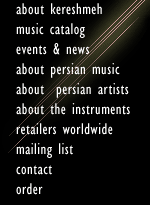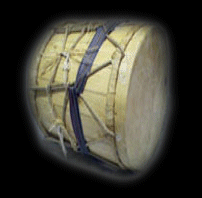 |
 |

|

Damâm The damâm is one of the most famous instruments in the south of Iran particularly in Booshehr used in most of the ceremonies of that region. The bowl of the damâm has a cylindrical construction covered by skin on both sides and fastened by straps and ropes on the sides. In general the damâm is held on the ground and played by both hands, but sometimes it is suspended from the neck with straps during performances. This instrument is particular to the south of Iran, and one can find instances of it in India as well as certain Arabic and African countries.The dohol is one of the most widely used percussion instruments in joyous ceremonies by the Kurdish people, and is found in other parts of Iran as well as some other countries in the world. Along with the sorna (a wind instrument), the dohol is played during group dances. The dohol produces a very loud and voluminous sound. It has a cylinder like shape made of wood and both sides of the cylinder are covered with skin. The instrument is played by a stick in the shape of a cane in the right hand and a thin stick in the left. The cane like stick plays the strong beats of the rhythm, whereas the thin stick plays the ornaments and shorter beats. The dohol hangs from the performer's neck by a strap and is often played outdoors due to its high volume. |
|
|
Copyright © 1995-2021 Kereshmeh Records. -- All Rights Reserved.
|
||